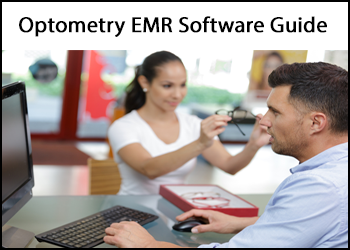EMR for Optometrists: Understanding the Cost Benefits of Implementation
Last Updated: January 06, 2023

Fact Checked By: Ashley Smith
On This Page
CostOwl.com note: Need an EMR software solution at an affordable price? Fill out the 30 second questionnaire below and our EMR software partners will send you free price quotes.
Optometry EMR is an electronic medical record (EMR) system that is optimized for professionals who specialize in eye care. These software solutions include features designed to support exams and treatment specific to optometry, as well as managing patient data. Practices choose from either cloud-based or server-based systems. Exam data is immediate and the best systems integrate with your current software solutions and workflow.

Pros of Optometry EMR #
Optometry EMR systems come with graphical annotation tools, which can auto-generate the appropriate ICD-9 or 1CD-10 codes that optometrists use for diagnoses. Some of these systems enable one-click access to the various types of eye exams occasionally or routinely performed by optometrists, such as device integration for refractions and keratometry. Optometry EMRs can be specifically configured to match different workflow needs and exam types required in an optometry practice. Optometry EMRs accommodate varying workflows due to their easy re-arrangement of exam types and configurations, and most also include configurable default settings that make it easier for eye care professionals to use them.
Points to Consider before Purchasing Optometry EMR #
- System architecture: Optometry EMR can be installed on computer servers housed within the practice. You may also choose cloud-based EMR or software-as-a-service (SaaS), meaning that the system can be accessed through the Internet. Choose a system architecture that is comfortable for all the optometrists at the practice. Each type has its own price, and so choosing one that is better suited to your environment can help you save money. Why pay for extra features that you don't need?
- Practice size: EMR software is specifically designed for a given number of users and types of users. This is also done with scalability in mind. Therefore, it is essential to select optometry EMR software that is appropriate for the total number of optometrists in the practice. The size also has a big effect on the total cost of the software. The larger the size, the more users and, ultimately, the cost.
- Certification: It is highly recommended to select an optometry EMR that is not only tested but certified by the authorized testing and certification authorities. This helps rule out problems later. It also helps to prove that the software is capable of performing all the functions that it is supposed and meets the standard criteria.
Sample Prices of Purchasing Optometry EMR #
The cost of an optometry EMR software system varies based on a number of factors. The first is whether you choose a web-based or self-hosted software, as most web-based systems cost significantly less than systems hosted onsite.
With a web-based solution, you pay a monthly fee. Onsite hosting requires purchasing the hardware, such as a network server, as well as licensing fees for each user. For both system types, the number of users also influences the overall price. The following estimates should help with budgeting, but an exact price is impossible without understanding your exact needs.
- The yearly price of an in-office optometry EMR can go as high as $50,000 to $60,000.
- The yearly price for a web-based optometry EMR can be as high as $30,000 to $40,000.
- The estimated cost of buying and installing optometry EMR ranges from $10,000 to $80,000 per provider.
- A Microsoft certified technician, especially during the initial phase is necessary, which will cost you between $50 and $150 per hour.
- Dual servers in the workplace cost around $3,000 to $4,000.
- Each workstation can cost you around $150 to $200 so, depending on the total number of workstations, the total price of the EMR can rise.
- A diagnostic equipment interface can cost you between $5,000 and $6,000.
- Data storage ranges between $800 and $1,000 in total for a tape drive, followed by a monthly price of $50 to $75.
- Support costs may run you between $1,000 and $2,000 per year.
Resources:
